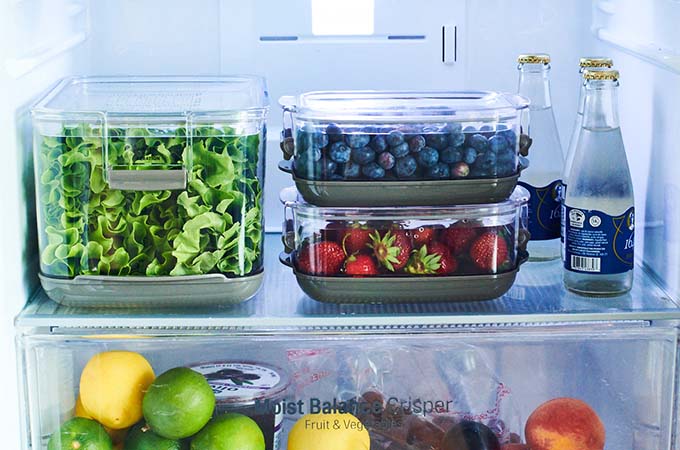
Annie Ferland is a nutritionist, Doctor of Pharmacy and founder of Science & Fourchette, a credible, independent online nutrition platform. A passionate science communicator and unconditional fan of the pleasures of eating, she simplifies the science behind every bite.
1. Consult the flyers
It’s easier to spot significant discounts when you study the flyers every week. Since substantial promotions are usually found in the first few pages, use those to plan your meals. And don’t forget that promotions come back every 4 to 8 weeks so it can be useful to note when your favourite products pop up, and wait for the next sale to buy them again.
2. Flexibility in recipes
Do you dare replace the red pepper in a recipe with a green pepper at half the price? By getting into the habit of regularly using anti-waste apps, you can also find a lot of food that’s slightly wilted, or whose expiry date is near, but that is still good. Bulk and frozen foods are also gold mines for much cheaper options.
3. Less meat, more money
We eat less meat for our health and for the environment, but we can also do it to reduce our grocery bill! Try out tofu, tempeh, legumes, “meatless” products, edamame or textured vegetable protein (PVT). If you get into the habit of replacing 454 g (1 lb) of minced meat per week with an equivalent amount of vegetable protein, you can save nearly $250 per year.
4. Fridge snapshot
You can save a lot by taking inventory of what you still have at home—a step that many of us overlook for lack of time. The solution? Take a picture of everything! Then, once at the grocery store and in doubt, check what you have on your shelves before buying.
Does the 900 g yogurt format give you more bang for your buck than the 650 g yogurt? To be sure to make the most economical choice—regardless of the discount or the format at the time of purchase—look for the price per 100 g or 100 ml on the label placed directly on the shelves (yes, the very small one!). It’s a good habit to get into, since many experts agree that consumers who rely on the price per unit of measure to make their selection generally make the best choices for their wallets.
5. The more it’s seen, the more it’s sold
The arrangement of products at the grocery store is thought out to seduce us and multiply unplanned purchases. Brands pay a lot of money to get the spaces on the shelves located at eye and hand level. So, if you look at the top or bottom of the shelves, you can find great savings and often more nutritious products. And to avoid needless spending, be guided by your pre-written grocery list.
6. Minimize waste, maximize the fridge
According to statistics, food waste is equivalent to nearly $1,100 a year of items thrown in the garbage. To ensure that nothing is lost, adopt a rule of “first food in, first food out.” You can also make “fridge cleaner” dinners by placing all the leftovers on the counter to get a better look. It’s simple, but effective.

ZERO WASTE
All Our Recipes
7. The fake discount
It is often thought that the products featured at the end of the aisles, or stacked in a giant pyramid, are extraordinary bargains. This may not be the case! These are popular places for manufacturers, since they know that their products will be sold in large quantities. Before putting them in your basket, look at the price by weight to see if you’re really in front of a true discount (see the explanation above).
8. The truth about “shrinkflation”
Do there seem to be fewer cookies in your box? And is that juice bottle slightly smaller than last time? You’re not losing your mind; brands are subtly reducing the quantities of their products without lowering the price. “Shrinkflation” is a common practice for food giants to increase prices without it being obvious. To get around this phenomenon, again use the price-by-weight display and opt for private labels. In addition to being cheaper, they are less inclined to use this tactic.
This year, dairy, vegetables and bakery products are expected to be the most affected by price increases. All of this is due to the turmoil caused by the pandemic, the labour shortage, transportation costs and climate change. The price of meat, which has already risen significantly over the years, should remain more stable, but still expensive per kilo.
9. Back to basics
You always save when you cook your own meals, snacks and desserts, since the price of basic products, such as eggs, flour, sugar and milk, has increased very little or not at all over the years. Not surprisingly, meal boxes, ready-to-eat and ultra-processed foods will always drive up our bills in a dizzying way, even if they can help us out from time to time.
10. Do it yourself
The peeled mini-carrots, grated cheese and washed salad are convenient—and certainly save us preparation time—however, the range of minimally processed, fresh foods comes with a heftier bill for the consumer. We found that if we removed 10 fresh-processed foods per week from our basket and replaced them with the same staple (and a little more time), we saved nearly $900 a year.
To find everyday economical meal ideas, consult our selection of budget-friendly recipes.


